Related Topics
Particular Sights to See:Center City
Taxi drivers tell tourists that Center City is a "shining city on a hill". During the Industrial Era, the city almost urbanized out to the county line, and then retreated. Right now, the urban center is surrounded by a semi-deserted ring of former factories.
Touring Philadelphia's Western Regions
Philadelpia County had two hundred farms in 1950, but is now thickly settled in all directions. Western regions along the Schuylkill are still spread out somewhat; with many historic estates.
Victorian Broad Street

|
| Broad Street |
Starting at the Delaware River and walking East-West on Spruce Street, it is possible to envision an architectural museum which begins in 1702 and ends at the Schuylkill River about two hundred years later. As Spruce Street crosses Broad (14th Street), it reaches the level of Victorian architecture, and for this discussion, we now face North on Broad Street and visit the string of solid masonry fortresses which exemplify Philadelphia at the height of the Industrial Revolution. At Broad and Locust Streets stands the old lady, the Philadelphia Academy of Music. Now reverted to its original purpose of presenting grand opera, the 1857 acoustical mansion long housed the Philadelphia Orchestra. Electricity has replaced gaslight, and there are a few elevators to the upper balconies. But the Academy is a surviving example of a class of music halls which once dominated every large city in the Western world. Opera hasn't changed; why should the Academy?
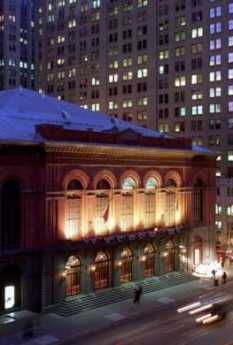
|
| Academy of Music |
A book called Philadelphia Scrapple, written by several anonymous Philadelphians, gives a succinct description of the conception and design of the Academy building:
"Joseph R.Ingersoll became chairman of a committee to secure subscriptions for a building fund. When what was thought to be an adequate fund had been raised, the committee for the building went to consult Napoleon Le Brun and his partner about plans.
" Mr. Le Brun asked the committee how much money they had to work with. In Mr. Le Brun's own words:
"' Upon their telling us, we said you cannot build a beautiful opera house inside and outside both for that amount, but you can build the interior thoroughly complete and build the outside perfectly plain and simple like a market house, and if you ever have the money later on you could easily face it with marble and make the exterior beautiful, too.
' When the question was asked us, "If we do that how are we to know that the acoustics will be thoroughly good in every respect?", I replied that there was but one large theatre in the world at that time that was perfect acoustically, and that was La Scala at Milan, and that to be quite sure of the new Academy before we began to build, the Scala interior, stage, and auditorium should be duplicated.'
"To aid in securing acoustic perfection, over and above the meticulously studied proportions and dimensions, there is an intricately-devised system of inverted barrel-vaulting underneath the orchestra and, underneath the centre of the parquet, a counter-vaulted sounding well, walled in with bricks, 12 feet deep and 20 feet in diameter."
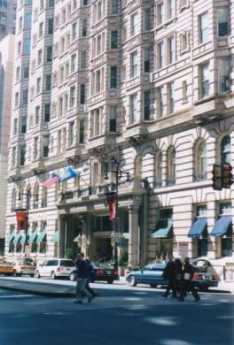
|
| Bellevue |
Just a little further North of the Academy is the Bellevue, which was long called the Bellevue Stratford, but which now has a Hyatt Hotel on the top floors, and a food court in the basement. Because of the tax laws, for a century it has been shrewd to sell a hotel every seven years, often just trading it with a similar hotel which is also at the seven-year point. In the case of the Bellevue, this grand hotel in the European style changed its name for more than one reason, mainly because in 1976 it was the scene of the discovery of a new disease, Legionnaire's Disease. As it turned out, this bacterium was especially favored by growing in water-cooled air conditioning equipment and made its epidemic debut when the American Legion held its convention at the hotel for the bicentennial of the Declaration of Independence. The epidemic almost destroyed the attendance at the bicentennial, bankrupted the hotel, and represents a historical moment that everyone hopes to forget. The hotel is just too stately, comfortable and charming to disappear, and eventually, the Legionnaire story will just be a curiosity. John B. Kelly, the father of Grace, once the Mayor of the town, and a Democratic power baron, used to hold court at lunch every day in the main dining room. The Republicans, of course, held a daily luncheon war dance at the Union League a couple of doors away, and you had to be careful where you ate lunch if you had political involvements. Although the ballroom of the Bellevue was the only place for a debutante function or a really fancy banquet, there were many hostesses who were uneasy about going to the place which was the center of Democrat politics and felt they had to ask around before they announced a decision.
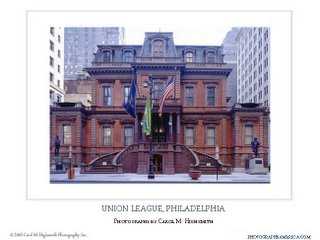
|
| Union League |
And a few steps North of that, at Broad and Samson Streets, stands the Union League itself. Not the Union League Club, please, that's a name used in other cities; this is the home of the franchise, the Union League itself. Although it's a house, it is a very big brownstone house, attached to another building in the rear which must be ten times as large. When you are inside, you pass from the 1860 building to the 1902 building without noticing the change but viewed from the outside, it is easy to overlook the connection. Brownstone is soft and easily attacked by the weather, so the League requires a lot of maintenance. And gets it; the place is spick and span. If you appear there without a jacket or tie as someone's guest, they won't eject you, but they will wordlessly bring you a jacket and tie to wear, and most people don't have the brazenness to do it twice. Inside, the furnishings are comfortable but reflective of the Civil War origins of the club, with marble floors and walnut walls, stained glass windows and awesome rooms dedicated to Lincoln and other Republican Presidents, plus Civil War Admirals and Generals. One of the dozen dining rooms is outfitted like a Victorian saloon, with portraits of semi-nude buxom ladies on the wall that once graced the walls of Edward Stotesburyand others with needlepoint furniture on oriental rugs for the ladies to have afternoon tea. You can hold a wedding banquet in one room, and a cigar-smoking bachelor brawl in another, without one group likely to see the other.
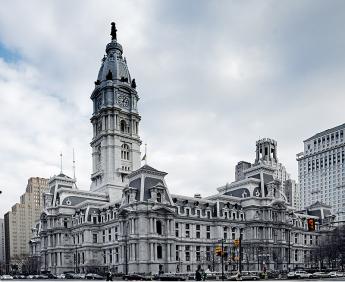
|
| Philadelphia City Hall |
At the head of Broad Street, dominating the view from the middle of the street, is City Hall. When it was designed in 1858, it was to have been the tallest building in the world, but politics intervened, and when it was completed in 1888, the Eiffel Tower and the Washington Monuments were taller. It is almost impossible to guess how opulent and ornate City Hall once was, but a guided tour is provided, and with coaching, you can see the huge staircases, the arching ceilings, the palatial offices for the Mayor, City Council and the Supreme Court. You can take a 44-story elevator ride, but you can no longer go up to Willam Penn's hat. The views of the city are spectacular, showing off the rivers, the parkways, the clusters of skyscrapers, and the vistas of Broad Street, stretching North and South to form what is said to be the longest straight road in the country. A tour of City Hall, which most residents never bother to take, teaches an impressive lesson in the way the city residents once loved their town, contrasted with the shabby neglect and decay which now overtakes city politics. For years it was said that City Hall should be torn down and replaced with something functional. But anyone who tours the place today comes away appalled at such an idea. The demolition cost alone makes the project indefensible. No one can now guess whether the future holds a revival of reverence for this massive monument, or whether, like the statue of Ozymandias, it is destined to lose all significance except to point a moral or adorn a tale.
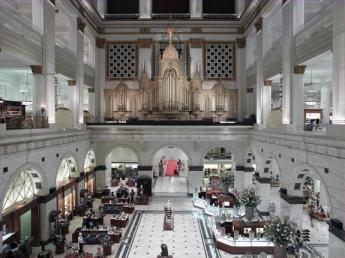
|
| Wanamaker's |
To go further north on Broad Street, you must go either East or West around City Hall. To the East is a department store striving to keep up the standards set at that location by John Wanamaker, who made famous the saying that the customer is always right. Or, going West around City Hall, you might tip your hat to the place where the old Pennsylvania Railroad had its Broad Street Station. It's hard to believe, but the trains from Washington and New York really did puff and jingle right up to fifty yards from the Mayor's office. They came into Center City on an elevated track, creating a barrier long known as the Chinese Wall. After the tracks were removed, the urban land became the railroad's most valuable property, and may eventually become the center of a city moving slowly westward.
On Broad Street North of City Hall are two more notable Victorian buildings, and then we'll stop. On the East corner, at what is known as number one North Broad Street, is the Masonic Temple, looking like a Norman church or fortress, which is much the same thing. The Masons were here first. Their temple was moved here in 1873, some fifteen years before City Hall was completed. It is likely, however, that the plans were made after 1851 when City Hall was originally conceived, and the Masons were just more skillful in getting a building built, as you naturally might expect of them. And what a building. There are seven meeting rooms inside which would rival in size the auditorium of most good-sized churches. Cantilevered staircases astound the viewer, and there are acres of marble flooring and paneled walls, hung with portraits of former masons, like George Washington and Benjamin Franklin. Different components of the organization, like Knights Templar, can meet simultaneously, and the size of the rooms gives some idea of the size of the organization. In fact, it is only part of the Pennsylvania Chapter, since the Shriners are somewhere else. The Masons have always been bewildered by a Pope who once ordered his faithful to abstain from Freemasonry, a dispute possibly having to do with the Twelfth Century disputes of the Popes at Avignon and the confiscation of the Knights Templar, but it's hard for an outsider to judge. The Masons will invite you to join, but they won't tell you what they do until you join. If you don't know what an organization is all about until you join, it's an impediment to membership recruitment. Or perhaps it's the other way around. Perhaps it is a testimony to the large number and esteemed public reputation of its members that so many can be induced to join, purely out of respect for the people they know who are already members. In any event, Masons certainly can build impressive buildings. If you are one of the many people who have lived in Philadelphia for six decades without visiting the place, make a note to go there soon.
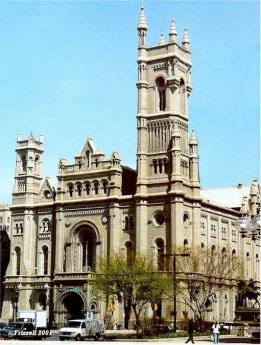
|
| Masonic Temple |
And then the final stop on the tour, the Pennsylvania Academy of Fine Arts. For the moment, never mind the towering reputation and history of this cradle of American Art, of Eakins and Rush and Peale. Just look at the looming red building designed by Frank Furness on Cherry Street, all massive and funny-looking and Egyptian or something. First of all, it would be wise to learn how to pronounce his name, which is more like Furnace than fur-Ness, since there are lots of descendants around who are in a position to snub you if you stumble. It's maybe a little hard to understand why a building has to be so massive to hold pictures at an exhibition, but perhaps the thought simply was to make it cheaper to leave it standing than to tear it down. The City moved away from the Academy of Fine Arts, and now it is moving back again, but the permanent collection never changes. Some say that the modern exhibitions never change, either, but that's just post-modern slander. In time, the Academy will overcome.
Originally published: Monday, June 26, 2006; most-recently modified: Wednesday, May 29, 2019
| Posted by: bobbi | Feb 20, 2010 5:31 PM |